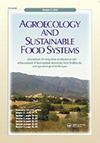Introduction to the Special Issue: Reconciling Production and Conservation at the Landscape Scale
引用次数: 2
Abstract
The need to reconcile agriculture and the environment is widely shared by scholars and the subject of many papers in recent scientific literature. However, the means to reach this goal are varied. Some solutions offer minor adjustments to existing practices. Adjusting fertilizer use through precision agriculture techniques, for example, or substituting tillage with herbicides, like in conservation agriculture, are solutions that basically rely on the same conventional paradigm of modifying the environment, mainly through the use of external inputs. A recent paper in a widely respected journal (Foley et al. 2011) proposes strategies to address the twin challenges of food security and environmental sustainability by 1) stopping clearing new land for farming, 2) increasing yields, 3) increasing resource use efficiency (e.g. water, nutrients), and 4) increasing food delivery (shifting diets and reducing wastes). These approaches basically do not consider it possible to farm and at the same time protect and maintain a natural environment. It is either one or the other. They try to prevent problems and reduce risks (pollution, wastes, excessive irrigation, etc.) but do not propose alternatives. Such approaches may decrease agriculture's environmental footprint, but will certainly not get to the bottom of our food system problems. As Einstein once put it: "Problems can't be solved by applying the same ideas that created them." (Resume d'auteur)特刊导论:在景观尺度上协调生产与保护
协调农业和环境的必要性是学者们广泛认同的,也是最近科学文献中许多论文的主题。然而,实现这一目标的手段是多种多样的。一些解决方案提供了对现有实践的微小调整。例如,通过精确农业技术调整肥料的使用,或者像在保护性农业中那样用除草剂代替耕作,这些解决方案基本上依赖于主要通过使用外部投入来改变环境的相同传统范例。最近在一份广受尊敬的杂志上发表的一篇论文(Foley et al. 2011)提出了解决粮食安全和环境可持续性双重挑战的策略,包括:1)停止开垦新的耕地,2)提高产量,3)提高资源利用效率(如水、营养物质),以及4)增加食品配送(改变饮食和减少浪费)。这些方法基本上不认为在耕作的同时保护和维持自然环境是可能的。不是一个就是另一个。他们试图防止问题和减少风险(污染,浪费,过度灌溉等),但不提出替代方案。这些方法可能会减少农业的环境足迹,但肯定不会触及我们粮食系统问题的根本。正如爱因斯坦曾经说过的:“问题不能通过应用产生问题的相同想法来解决。”(简历d 'auteur)
本文章由计算机程序翻译,如有差异,请以英文原文为准。
求助全文
约1分钟内获得全文
求助全文

 求助内容:
求助内容: 应助结果提醒方式:
应助结果提醒方式:


